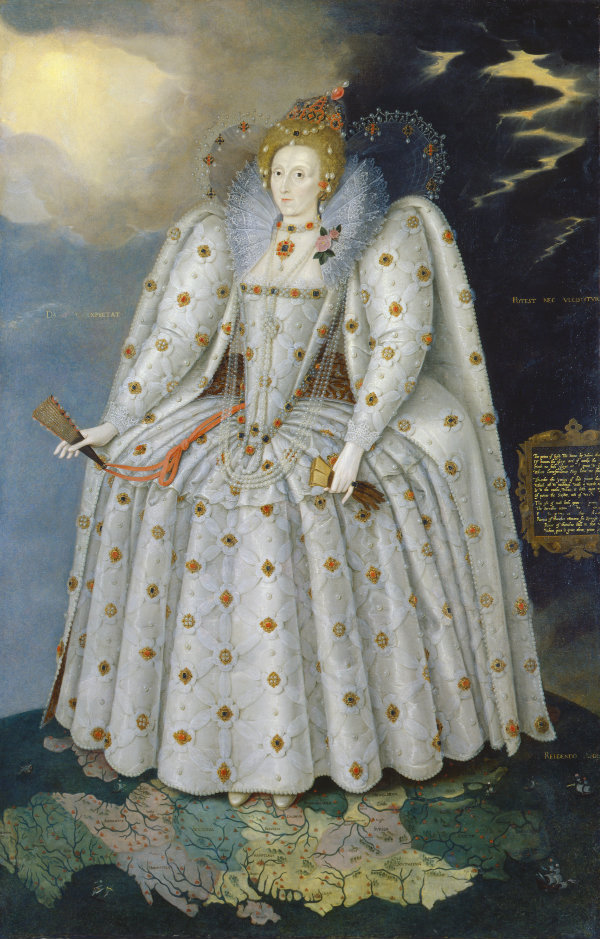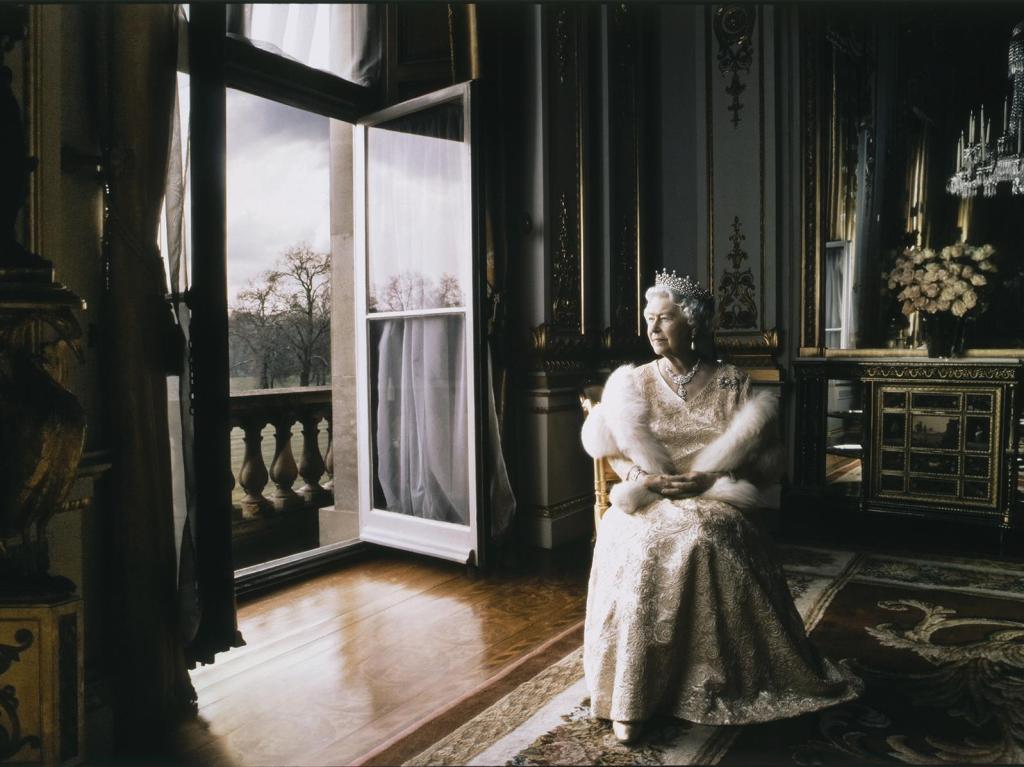Queen Elizabeth II by Annie Leibovitz, 2007 Official Portrait of HRH Queen Elizabeth II © 2008 Annie Leibovitz, courtesy of the artist.
In Nicola Jane Philipps’ 2009 portrait of Princes William and Harry, her subjects are relaxed, almost casual despite the formality of the uniforms they wear. William leans against a wall, Harry is seated. Instead of wearing hats and gloves they clutch such accoutrements in their hands. It’s almost as if the painter has caught the Princes off-duty, in a moment of warm, easy intimacy.
It’s a significant departure from Marcus Gheeraerts the Younger’s famous portrait of Queen Elizabeth I painted circa 1592, in which the Queen’s pose is stiff, her gaze direct and imperious, her bearing regal. Bedecked with jewels and bestriding a map of the world, Gheeraerts’ painting is a quintessential portrayal of power and authority.
Viewed together, these portraits present two very different views of royalty, speaking to the different times in which they were painted while also showing us exactly what the sitters wanted us to see.
‘I think we’re fascinated by portraiture because it can both conceal and reveal – it’s got both capacities,’ said Tansy Curtin, Curatorial Manager at Bendigo Art Gallery.
Opening on 16 March, and showing until 14 July, Tudors to Windsors: British Royal Portraits is exclusive to Bendigo Art Gallery, and features more than 200 artworks on loan from the National Portrait Gallery of London.
‘Some of these works of art are 400 or 500 years old but they’re still very relatable in lots of ways,’ said Curtin.
‘We can still understand the sitters, empathise with them – we perhaps don’t understand the symbolism of the paintings as well as the Tudors themselves would have, but we have that capacity to interpret the majesty, the power of the Royal Family and I think that’s what’s so interesting.
‘For instance, the wonderful “Ditchley” portrait of Queen Elizabeth the First by Marcus Gheeraerts is an incredible work. It’s physically huge but it really shows the monumental power of portraiture for Queen Elizabeth; the way that she used it, manipulated it, to show her strength of character and the strength of her Protestant monarchy,’ Curtin said.

Queen Elizabeth I (The ‘Ditchley’ portrait). By Marcus Gheeraerts the Younger, c.1592 © National Portrait Gallery, London.
In contrast, Annie Leibovitz’s official portrait of Queen Elizabeth II, taken in 2008, shows a much more relatable image of royalty.
‘The Queen is sitting down, she’s looking away from us, and she’s an older woman – she’s allowed to look older, whereas of course Elizabeth the First controlled the way that she was portrayed in that she wasn’t allowed to age in her portraits.’
An emphasis on showing the human side of the Royal Family can be traced back to the Victoria era, according to Curtin.
‘Photography had a big impact on the representation of the monarchy – Queen Victoria really picked up on photography as a medium for conveying the approachable aspect of the Royal Family – showing portraits of her family, her on her estate in Balmoral. It’s something that really comes through from Victorian times to the present,’ she told ArtsHub.
DYNASTIC STORIES
Presented chronologically in order to show the stories of successive royal dynasties, Tudors to Windsors: British Royal Portraits will feature family trees and timelines in each section of the exhibition, illuminating not just the relationships between individuals but also exploring the world in which they lived.
‘So for example with the Tudors, you will see that in 1485, Henry Tudor defeated Richard III, and then just a few years later, in 1492, Christopher Columbus encountered the Americas. So the timelines will give you that perspective on what was happening on a minute scale but also on a global scale.’
Complementing the works from the National Portrait Gallery are pieces on loan from other institutions and offering further insights into the lives of the Royal Family down through the ages.
‘So for example we have Queen Elizabeth the First’s coronation glove, which is coming to us from Dents Glove Museum in the UK – it’s never left the UK before but it’s coming to us, which is quite incredible – a 460 year old glove.
‘And then I’ve got a suit of armour coming from the Royal Armouries that is thought to have been worn by Henry the Eighth’s son, Edward, who died aged just 16.’
Other items come from closer to home. ‘The State Library of Victoria has an incredible collection of items related to the English Civil War, so we’re borrowing a copy of their Eikon Bailike, which is in a way Charles the First’s manifesto. It was released just ten days after he was executed and has a beautiful cover featuring an embroidered portrait of Charles the First. We’ve also some letters from Charles to members of his family as well – and all these wonderful things are part of our State Library’s collection here in Victoria,’ Curtin said.
MODERN ROYALS
In addition to artworks by the likes of Thomas Gainsborough and Cecil Beaton, the exhibition also features more recent works, including the official wedding portraits of the Duke and Duchess of Sussex, Prince Harry and Meghan Markle, and Prince William and Catherine, the Duchess of Cambridge.
‘I think the royal-watchers will love the contemporary side of the exhibition. And the last room of the exhibition is going to be spectacular – that’s where you’ll see the Annie Leibovitz and the Thomas Struth, a wonderful German photographer – it’s worth going anywhere just to see his work. But also there’s a fabulous Andy Warhol in there, and very contemporary Royals, so Meghan and Harry, and of course Prince William and Catherine Middleton – who is the Patron of the National Portrait Gallery, so it’s really nice to have that connection as well.’
As well as Princes William and Harry, the exhibition also acknowledges their mother, the late Diana, Princess of Wales.
‘I think Diana holds a very special place in the hearts of so many people around the world. She came to Australia in 1983 and in fact she came to Bendigo, which was really lovely, and I’ve got some filmed footage of her visit to Bendigo in the exhibition as well.’
The exhibition also features a dress worn by Diana on that same tour.
‘It’s not the dress she wore when she came to Bendigo but one of the dresses she wore in Australia, which we’ve borrowed from Historic Royal Palaces in the UK, and when it’s finished here it will actually go into storage for a generation – it won’t be seen for quite some time because it’s been on display for such a long period. It was included in the Diana exhibition at Kensington Palace last year and so after coming to us it will have to go into a very nice darkened room for quite some time,’ Curtin chuckled.
Elsewhere in the exhibition, audiences can take in the Royal Family’s influence on pop culture, in a section featuring everything from a Mattel Barbie doll of Elizabeth the First through to Hollywood film posters.
Even the popularity of successful Netflix series The Crown is reflected in the exhibition at the Bendigo Art Gallery.
‘The Crown has actually incited a new interest in Princess Margaret,’ Curtin explained. ‘Originally she wasn’t going to be included in the exhibition as much, but because of the excitement around that series, and particularly the portraits by Lord Snowden of Princess Margaret, she’s now quite an important part of the exhibition.
‘And when you look at those photographs, they’re incredible – they’re amazing photographs. So it’s really nice to be able to draw Princess Margaret back into the exhibition as well – and through that we can see how contemporary culture is influencing our understanding of the arts.’
Tudors to Windsors: British Royal Portraits is showing exclusively at Bendigo Art Gallery from 16 March to 14 July 2019. For details visit www.bendigoartgallery.com.au/tudorstowindsors





